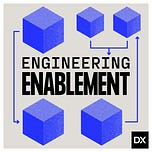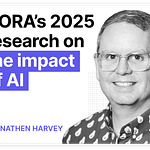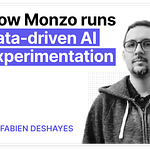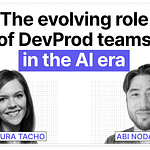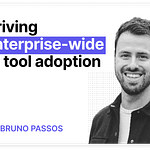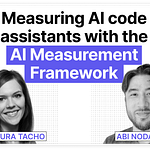Listen and watch now on YouTube, Apple, and Spotify.
In this webinar, Abi Noda and I explore how engineering leaders can plan their 2026 AI budgets amid rapid change and rising costs. Using data from DX’s recent poll and industry benchmarks, we break down how much to spend per developer, how to allocate budgets across tools, and how to balance innovation with cost control.
We also discuss practical strategies for building a multi-vendor approach, choosing the right metrics before and after adoption, and proving ROI through continuous measurement. Along the way, we share insights on communicating AI’s value to executives, avoiding cost-cutting narratives, and investing in enablement and training to make adoption last.
Some takeaways:
Planning Your 2026 AI Budget
Budgets are shifting from experimental to essential. In 2024–2025, most AI tool spending was discretionary and exploratory, but by 2026, it becomes a recurring line item with clear ROI expectations.
Expect rising costs. Tools are expanding their capabilities and pricing accordingly; organizations should plan for year-over-year increases.
Average spending is climbing. The floor for AI tooling is now about $500–$1,000 per developer per year, but multi-vendor setups can easily push that higher.
Allocating your AI budget
Plan for diversity across the SDLC. Modern AI adoption means using multiple tools—chat interfaces, IDE copilots, background agents, and specialized tools—to cover distinct use cases.
Shift from headcount expansion to efficiency. Many companies are reallocating budget from new hires to automation and tooling—not cutting jobs, but slowing growth to focus on productivity.
Track budget maturity. Move from “experimental” AI spending to a structured budget that includes telemetry, measurement, and enablement layers.
Vendor and tooling strategy
A multi-vendor approach is now the norm. Locking into one platform risks missing out on faster-evolving tools and model improvements.
Enterprise licensing vs. stipends. Enterprise plans streamline enablement and reporting but carry overage risks; stipends are predictable but lack team-level visibility and economies of scale.
Cost control is an active process. Use telemetry and regular reviews to ensure spending aligns with actual value delivered across teams.
Measurement and ROI
Use data before and after adoption. Measure both during proof-of-concepts and in production to understand which tools truly move the needle.
The right metrics matter. Track usage tiers (daily, weekly, monthly), time savings, developer satisfaction, and percentage of AI-generated code—while acknowledging how hard these are to measure accurately.
ROI is more than throughput. Developers spend only about 14% of their time coding; improving that slice doesn’t guarantee overall productivity gains.
Communication and leadership
Frame AI as acceleration, not automation. Messaging that focuses on cost-cutting can backfire—leaders should position AI as a way to stay competitive, not reduce headcount.
Language matters. Talk about time recaptured or capacity gained instead of cost savings to avoid triggering budget cuts.
Leadership advocacy drives adoption. Developers are far more likely to use AI tools daily when leaders promote them clearly and consistently.
Enablement and training
Training is non-negotiable. AI adoption stalls without enablement; companies investing in experiential training see stronger, sustained usage.
High-quality programs pay off. Workshops and accelerators that pair real business problems with hands-on learning cost roughly $500–$2,000 per developer—and are worth every dollar.
Measure enablement ROI. Track adoption rates before and after training to validate impact and justify continued investment.
Trends to watch
AI add-ons are expanding. Expect price hikes as existing tools add AI features—often as premium tiers or separate modules.
Custom models are not yet mainstream. Fine-tuning and bespoke models are still limited to large enterprises; most companies can focus on leveraging general models effectively.
Data-driven decisions will define leaders. Teams that collect usage data, track ROI, and adjust budgets proactively will outpace those relying on assumptions.
In this episode, we cover:
(00:00) Intro: Setting the stage for AI budgeting in 2026
(01:45) Results from DX’s AI spending poll and early trends
(03:30) How companies are currently spending and what to watch in 2026
(04:52) Why clear definitions for AI tools matter and how Laura and Abi think about them
(07:12) The entry point for 2026 AI tooling budgets and emerging spending patterns
(10:14) Why 2026 is the year to prove ROI on AI investments
(11:10) How organizations should approach AI budgeting and allocation
(15:08) Best practices for managing AI vendors and enterprise licensing
(17:02) How to define and choose metrics before and after adopting AI tools
(19:30) How to identify bottlenecks and AI use cases with the highest ROI
(21:58) Key considerations for AI budgeting
(25:10) Why AI investments are about competitiveness, not cost-cutting
(27:19) How to use the right language to build trust and executive buy-in
(28:18) Why training and enablement are essential parts of AI investment
(31:40) How AI add-ons may increase your tool costs
(32:47) Why custom and fine-tuned models aren’t relevant for most companies today
(34:00) The tradeoffs between stipend models and enterprise AI licenses
Where to find Abi Noda:
• LinkedIn: https://www.linkedin.com/in/abinoda
• Substack: https://substack.com/@abinoda
Where to find Laura Tacho:
• LinkedIn: https://www.linkedin.com/in/lauratacho/
• Website: https://lauratacho.com/
• Laura’s course (Measuring Engineering Performance and AI Impact): https://lauratacho.com/developer-productivity-metrics-course

